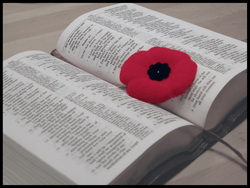
We mark Remembrance Day on November 11. This year my thoughts turn to three specific souls who were lost in World War I.
Thanks to Global TV Toronto's incredible Canada Remembers website, Torontonians can find out about WW I soldiers who paid the ultimate price using its interactive map.
www.globalnews.ca/topics/canadaremembers2012
Sergeant Frank Jarrett, Sapper Edward M. Agnew (Military Engineer) and Private Arthur C. White, these three men either lived or had next of kin who lived on Gould, Mutual and Church Streets; streets I walk every day.
The Global TV map also links to www.canadiangreatwarproject.com, where you can find a wealth of information including their ages, occupations, when and where they enlisted, where and how they perished, where they rest - among other details.
Jarrett was a married butcher who enlisted late in 1915. He was a tall and handsome man at 30 who was assigned to The Second Battalion of the Canadian Railway Troops (CRT). The CRT built the railway networks that supplied the Front. He had served previously with the 24th Canadian Regiment and the 7th Canadian Mounted Rifles. He died four months after he enlisted and is buried in Oxfordshire, England.
http://www.veterans.gc.ca/eng/collections/virtualmem/photoview/392953/117097
A sapper is a soldier that has engineering duties. Originally used to build trenches under fire in ancient warfare, the term comes from the old French word sappe which means spade. Agnew also served the CRT, in the 5th Battalion. He was a successful engineer working on a project in Northern Manitoba and left to enlist in Winnipeg in January 1916. He lied about his age, saying he was 43, when he was actually 53. Agnew was wounded by shrapnel while repairing a rail line near Ypres in October 1917. He was evacuated to England, and then to Toronto a year later, to recover. He was discharged as medically unfit for duty a week after the war ended. Sadly, Agnew died of his injuries in the summer of 1919 and is buried in Prospect Cemetery on St. Clair Avenue West. His wife lived on Mutual Street.
http://www.veterans.gc.ca/eng/collections/virtualmem/photos/425945
Arthur White was a chauffeur and enlisted on February 1, 1916 at 26. He joined Toronto 169th Battalion. He fought in Belgium and was reported missing October 13, 1917. It is likely that he died in the first Battle of Passchendaele. Not much is known about how he died and his body was never recovered. White's name is inscribed on the Menin Gate Memorial in Ypres, the memorial was erected for soldiers who were killed and whose graves are unknown.
http://www.veterans.gc.ca/eng/collections/virtualmem/photos/1596996
On this day, I am grateful for the sacrifices these men made so that we can all be free.
Thanks to Global TV Toronto's incredible Canada Remembers website, Torontonians can find out about WW I soldiers who paid the ultimate price using its interactive map.
www.globalnews.ca/topics/canadaremembers2012
Sergeant Frank Jarrett, Sapper Edward M. Agnew (Military Engineer) and Private Arthur C. White, these three men either lived or had next of kin who lived on Gould, Mutual and Church Streets; streets I walk every day.
The Global TV map also links to www.canadiangreatwarproject.com, where you can find a wealth of information including their ages, occupations, when and where they enlisted, where and how they perished, where they rest - among other details.
Jarrett was a married butcher who enlisted late in 1915. He was a tall and handsome man at 30 who was assigned to The Second Battalion of the Canadian Railway Troops (CRT). The CRT built the railway networks that supplied the Front. He had served previously with the 24th Canadian Regiment and the 7th Canadian Mounted Rifles. He died four months after he enlisted and is buried in Oxfordshire, England.
http://www.veterans.gc.ca/eng/collections/virtualmem/photoview/392953/117097
A sapper is a soldier that has engineering duties. Originally used to build trenches under fire in ancient warfare, the term comes from the old French word sappe which means spade. Agnew also served the CRT, in the 5th Battalion. He was a successful engineer working on a project in Northern Manitoba and left to enlist in Winnipeg in January 1916. He lied about his age, saying he was 43, when he was actually 53. Agnew was wounded by shrapnel while repairing a rail line near Ypres in October 1917. He was evacuated to England, and then to Toronto a year later, to recover. He was discharged as medically unfit for duty a week after the war ended. Sadly, Agnew died of his injuries in the summer of 1919 and is buried in Prospect Cemetery on St. Clair Avenue West. His wife lived on Mutual Street.
http://www.veterans.gc.ca/eng/collections/virtualmem/photos/425945
Arthur White was a chauffeur and enlisted on February 1, 1916 at 26. He joined Toronto 169th Battalion. He fought in Belgium and was reported missing October 13, 1917. It is likely that he died in the first Battle of Passchendaele. Not much is known about how he died and his body was never recovered. White's name is inscribed on the Menin Gate Memorial in Ypres, the memorial was erected for soldiers who were killed and whose graves are unknown.
http://www.veterans.gc.ca/eng/collections/virtualmem/photos/1596996
On this day, I am grateful for the sacrifices these men made so that we can all be free.


 RSS Feed
RSS Feed